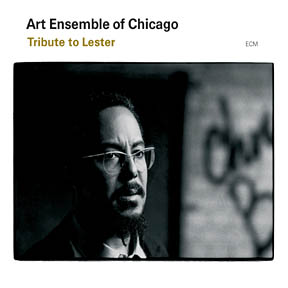Art Ensemble of Chicago - Tribute to Lester (ECM);
Art Ensemble of Chicago - The Meeting (Pi Recordings)
 The story so far: The Roscoe Mitchell Art Ensemble, unable to find the
audience they deserve in the US, relocate from Chicago to Paris in 1969.
(They are soon followed by the Creative Construction Company -
Anthony Braxton, Leroy Jenkins and Leo Smith - who don't meet with the
same success.) In Paris, Mitchell, Lester Bowie, Malachi Favors and
Joseph Jarman make a fast string of odd, exciting records, filled with
vocals and bicycle horns, poetry and attitude. They release 9 records in
2 years, are renamed The Art Ensemble of Chicago by a French
promoter, and meet up with American drummer Famadou Don Moye
before returning to the States in 1971.
The story so far: The Roscoe Mitchell Art Ensemble, unable to find the
audience they deserve in the US, relocate from Chicago to Paris in 1969.
(They are soon followed by the Creative Construction Company -
Anthony Braxton, Leroy Jenkins and Leo Smith - who don't meet with the
same success.) In Paris, Mitchell, Lester Bowie, Malachi Favors and
Joseph Jarman make a fast string of odd, exciting records, filled with
vocals and bicycle horns, poetry and attitude. They release 9 records in
2 years, are renamed The Art Ensemble of Chicago by a French
promoter, and meet up with American drummer Famadou Don Moye
before returning to the States in 1971.
Book II - The group becomes the biggest thing in avant garde jazz in the
1970s and '80s, perhaps the biggest production outside jazz has ever
supported - an organization with a huge touring company and
increasing professionalism as they record for the German label ECM and
the Japanese DIW. Their records become more polished but no less
brilliant. Each of the members pursue more and more side projects,
Bowie even joining Afrobeat legend Fela's band in Nigeria for a year. The
group seemingly can do whatever they want.
But things begin to waver. The early '90s see their two weakest records
to date, a pair of collaborations with an African vocal troupe. While
African culture had always been deep in the band's conceit, it seemed a
trendy move, their first following of fashion. Suddenly, they're sharing
muses, not just with the World Saxophone Quartet, but with Paul Simon
as well.
Book III - The group has its first change in membership since the
addition of Moye when Jarman quits to focus on his Buddhist studies in
his Brooklyn dojo. Their next album, Coming Home Jamaica
(Atlantic, 1998) is an even bigger disappointment and a subsequent
release, Zero Sun No Point (Leo, 2001) with percussionist
Hartmut Geerken, is better but barely noticed. In 1999, Bowie, the
charismatic trumpet player who charmed many fans into the fold, dies,
causing a major setback for the band.
It would seem the end of the mighty band, but they persevere as a sax
trio and after some less-than-spirited concerts begin to find their voice
again. And why not? Mitchell is one of the best saxophonists alive, and
he's backed by a great rhythm section with whom he's worked for 30
years.
Which brings us to the present, the last chapter of Book III and the first
of Book IV. Tribute to Lester is the first record by AECO-
as-trio and the group's fifth for ECM. With producer Manfred Eicher, the
group found a clarity of vision in the '80s, especially on Nice Guys and Third Decade. (Mitchell's Note Factory also released their
strongest disc, Nine to Get Ready on ECM.) Tribute
harkens back to those records with beautifully clean sound and
percussion driven tracks opening and closing the disc. But there is, as
might be expected, a somber quality to the record. They play Bowie's
fast bop "Zero" as a lament, sadly longing for a trumpet solo.
"Tutankhamun," a composition by bassist Favors dating back to 1969,
likewise has a yearning quality. "As Clear As the Sun" is a tour-de-force,
showing that Mitchell ranks with Braxton and Evan Parker as a fluent
master on the soprano. After a disappointing decade, Tribute
ranks among the band's best.
 Book IV begins with a surprise: the return of the mystic, Joseph Jarman.
The group played some quartet shows in Europe before recording
The Meeting. And if Tribute is about Bowie's departure,
The Meeting is about Jarman's return. The very first second of
the recording is Jarman's voice, so recognizable from the couple of
records they waxed for Atlantic in the early '70s, "Hail we now sing joy/
For the mighty warrior."
Book IV begins with a surprise: the return of the mystic, Joseph Jarman.
The group played some quartet shows in Europe before recording
The Meeting. And if Tribute is about Bowie's departure,
The Meeting is about Jarman's return. The very first second of
the recording is Jarman's voice, so recognizable from the couple of
records they waxed for Atlantic in the early '70s, "Hail we now sing joy/
For the mighty warrior."
The record is, in truth, more a meeting than a reunion (and shouldn't
count as a reunion until we see if Jarman is going to hang). The Art
Ensemble always relied on well-rehearsed heads and a remarkable
simpatico, but here there's a cautious hesitancy, a bit of feeling each
other out. "Hail We Now Sing Joy" could have used another take and
"Tech Ritter and the Megabytes" inexplicably fades after four great
minutes.
But even if it's unusual in the AECO sphere, such meetings are the stuff
of jazz, and it certainly doesn't come off as a first meeting. "It's the Sign
of the Times," "Wind and Drum," "Amin Budness" and "The Train to Io"
are percussion discussions in true Art Ensemble style, making up 43
minutes of the 59-minute disc. "Tech Ritter" is another of the jagged
R'n'B jaunts Mitchell likes to explore.
Moreover, and to me these words are very nearly holy, it's The Art
Ensemble. It's a joyful thing to hear these two horns together again.
So let us forgive those who said that they weren't the Art Ensemble
without Lester Bowie. Such are the sentiments of mourning philistines.
And with the emergence of this new Art Ensemble quartet, let us
welcome back to the path those who have strayed. Of course they're the
Art Ensemble, the great and mighty Art Ensemble, and we shall forgive
them, too, their missteps of the '90s. For they are the Funky AECO,
because they say they are. And if at some future time, Don Moye should
be the last one standing, I hope he does a drum solo and bills it as The
Art Ensemble of Chicago. And I hope I'm there to hear it.
Comments and Feedback:



More Recent Reviews, Articles, and Interviews @ The Squid's Ear...


|

